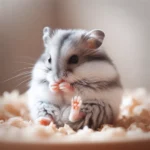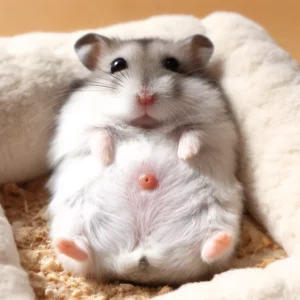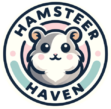Today, we’ll dive deep into the captivating world of hamster behaviors. From scent marking to hibernation patterns, these little cutie pie furballs exhibit a wide range of intriguing behaviors that offer a glimpse into their unique personalities and natural instincts. Buckle up as we explore the scientific research behind these behaviors and gain valuable insights into providing the best possible care for our beloved pets.
Why Understanding Hamster Behavior is Crucial
One thing that I learned about these tiny beings is that you need to read the silent cues in order to properly be able to take care of them. Its in the small things, and you if you do not know what to look out for that could put you or your hamster in more stress than needed. And I do not want that for you, nor do I want that for me. So, I am happy to share what I know, backed with studies and personal experiences.
Healthy and Normal Hamster Behaviors
Let’s start with the positive signs. These behaviors indicate that your hamster is healthy and happy:
- Pouching: Hamsters store food in their cheeks for transportation. This is completely normal and absolutely adorable. Hamsters can carry up to 50% of their body weight in their cheeks, using them to transport food, bedding material, and occasionally their young.
- Burrowing: Hamsters burrow to create their homes underground. If your hamster isn’t burrowing, it might be a sign to look into their environment. Burrowing is a natural behavior that helps them feel safe and secure. It is also really comforting to see them make themselves at home. Though, it may be harder to find them. I move to my hamster’s behavior at times, so if she doesn’t want to come out, then I come back at another time. She runs my home apparently.
- Scent Marking: Syrian hamsters have scent glands on their sides, while dwarf hamsters have them on their tummies. Scent marking is a normal behavior where they rub against objects to mark their territory. A study on scent marking by male dwarf hamsters (Phodopus sungorus campbelli) found that “male hamsters scent marked at greater frequencies in the presence of conspecific odor, either male or female, than in clean areas” [1].

- Going into Heat: Female hamsters go into heat every 4-5 days. This can be more noticeable in Syrian hamsters compared to dwarf hamsters.
- Grooming: Hamsters spend a lot of time grooming themselves. This is a sign that they are comfortable and feel safe in their environment. Grooming is a natural behavior that indicates a relaxed and content hamster. It is also really cute to watch!

- Scratching: Often associated with grooming, scratching is a normal behavior. However, excessive scratching might indicate a problem [1].
- Yawning: Yawning can look either adorable or terrifying, but it’s just a sign that your hamster is stretching and feeling relaxed. Yawning and stretching are signs of a comfortable and relaxed hamster.
- Nibbling: This can mean your hamster is curious or wants to be put down. It’s different from biting, which is more aggressive. It can feel like a gentle pinch on the skin. Your hamster may do this to simply warn you or this might be a common behavior they do to your hand.
- Licking: Some hamsters, like my little Espresso, love to give kisses. This can be a sign of affection or simply tasting your hand.
Stress and Fear Behaviors
It’s important to recognize when your hamster is stressed or scared. Here are some behaviors to watch out for:
- Bar Biting: This is a sign of stress or boredom. It’s dangerous for their teeth and indicates that something in their environment needs to change. Bar biting is often caused by a lack of enrichment or a too-small enclosure.
- Monkey Barring: Climbing and hanging from the bars of their cage can be dangerous and is a sign of stress or boredom. This behavior is typically related to a lack of enrichment and a too-small enclosure.
- Cage Pacing: Similar to bar biting, pacing back and forth is a sign of stress. This behavior is often seen in hamsters living in aquariums. I will often take my hamster out for some free roaming time if I ever see this happening.
- Screaming and Hissing: These sounds indicate fear. If your hamster is screaming or hissing, give them space and try to identify the cause of their fear [1].

- Wall Scaling: Jumping up and down against the walls of their enclosure can be a sign of stress or excitement. This behavior is typically seen in hamsters living in aquariums.
- Biting a Human: This is a defensive behavior. If your hamster bites you, it’s likely because they feel threatened or scared.
- Unpouching: If your hamster suddenly empties their cheek pouches, it might be a sign of stress or fear.
- Open Mouth: An open mouth can indicate fear. It’s a sign that your hamster is feeling threatened.
- Teeth Chattering: This is a warning sign to back off. It’s often seen when hamsters are introduced to each other.
- Freezing: This can be a sign of fear or assessing a situation. If your hamster freezes, give them time to feel safe. If you take your hamster out for free roaming and they hide or go under a hideout for a while, this is a sign the hamster is tried or ready to go back to their enclosure.
Health Assessment Behaviors
Regular health checks are crucial for your hamster’s well-being. Here are some behaviors that might indicate health issues:
- Excessive Itching: This could be a sign of skin irritation or parasites. A vet visit is necessary [1].
- Clogged Scent Glan: Especially common in male dwarf hamsters, a clogged scent gland needs to be cleaned regularly [1].

- Overgrooming: Similar to excessive itching, overgrooming can indicate parasites or other skin issues [1].
- Uncommon Behaviors: Any sudden changes in behavior, like a head tilt or walking sideways, should be checked by a vet [1].
- Diarrhea: This is a clear sign that something is wrong. Immediate attention is required [1].
Elderly Hamster Behaviors
As hamsters age, their behaviors change. Here are some signs of aging:
- Less Activity: Older hamsters become less active. This is normal, but a sudden change should be checked by a vet.
- Hair Thinning: Hair thinning is common in older hamsters. If your hamster is not old, this could indicate a nutritional deficiency.
- Weight Loss: Older hamsters might lose weight and become bonier. This is normal, but a sudden change should be checked.
- Decreased Appetite: This could be due to broken teeth or other health issues. Regular checks are important.
- Wobbling: Older hamsters might walk slower and wobble. This is normal aging behavior.
Activity Patterns and 24-hour a day body rhythm
Hamsters are known for their nocturnal nature, but their activity patterns can be influenced by various factors, including age and photoperiod (the duration of daylight). So not all hamsters may play during the night and sleep during the day. A study by Rosenberg et al. used a quantitative analysis approach to identify discrete bouts of hamster wheel-running activity and describe the age-related fragmentation in their 24-hour activity profiles. The researchers found that aging hamsters exhibited a more fragmented activity pattern, with shorter bouts of activity spread throughout the day and night [14].
Behavioral Enrichment and Playtime
Providing appropriate behavioral enrichment and playtime is essential for keeping our hamsters happy and healthy. A study by Haileyshamsters.com highlights the importance of recognizing and addressing common behaviors, such as burrowing, grooming, and scratching, as these are natural and healthy expressions of their instincts [1].
Engaging in playtime and offering a stimulating environment can help prevent unwanted behaviors like bar biting or cage pacing, which are often signs of stress or boredom. Providing tunnels, chew toys, and ample space for burrowing and running can help satisfy their natural curiosity and promote overall well-being.
Conclusion
Understanding your hamster’s behaviors is a fascinating journey that not only deepens our appreciation for these incredible creatures but also equips us with the knowledge to provide them with the best possible care. From scent marking and hibernation patterns to activity rhythms and stress responses, each behavior offers a unique glimpse into the intricate world of our furry companions.
By incorporating scientific research and expert insights, we can create an enriching environment that caters to their natural instincts and promotes their overall well-being. Remember, every hamster is unique, and it’s essential to observe and adapt to their individual preferences and quirks.
As responsible pet owners, it’s our duty to ensure that our hamsters live happy, healthy, and enriched lives. By embracing their fascinating behaviors and providing them with the care they deserve, we can forge a strong bond with these delightful creatures and create cherished memories that will last a lifetime.
—
Citations:
[1] https://www.thesprucepets.com/hamster-health-1236859
[14] https://www.reddit.com/r/hamsters/comments/185vuso/how_does_hamster_care_change_as_they_get_older/
[16] https://www.ncbi.nlm.nih.gov/books/NBK32656/
[17] https://iacuc.hms.harvard.edu/files/hma-iacuc/files/review_of_pain_assessment_methods.pdf

2 thoughts on “Decode Your Dwarf Hamster’s Body Language”
Hmm it looks like your blog ate my first comment (it was super long) so
I guess I’ll just sum it up what I wrote andd say, I’m thoroughly
enjoying your blog. I too am an aspiring blog blogger but I’m
still new to thee whole thing. Do you have any suggestions for novice blog writers?
I’d certainly appreciate it. https://odessaforum.biz.ua/
I am so sorry about that! But thank you! Also for new bloggers if you have heard anything about Wealthy Affiliate. They have helped me learn how to create a blog and keep the consistency going and support for my website when needed. If you want to check them out go here: http://www.wealthyaffiliate.com?a_aid=a93c47c1